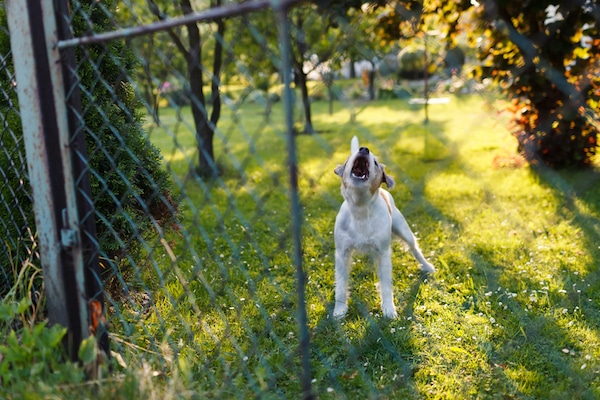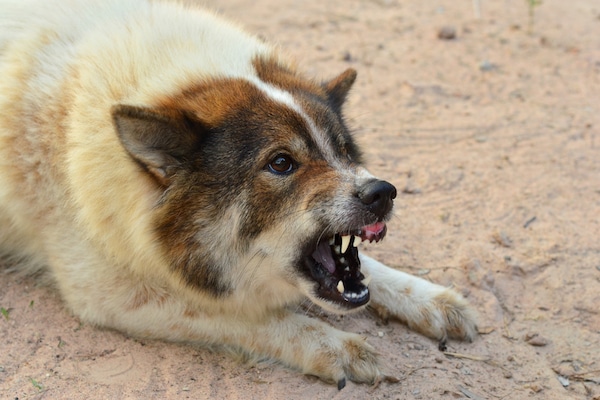Maybe you have one of these dogs: the kind who jumps, pulls, barks, and generally loses their mind when they see another animal or person. Or perhaps your dog barks at people who come into your home (not just the FedEx guy ringing the doorbell and dropping off a package). In fact, maybe it’s gotten so bad that you don’t walk your dog much anymore or have guests. You’re worried your pet may bite a person or another dog, and we all know what the consequences of that can be, especially for certain breeds (I’m talking about euthanasia).
But there’s an important distinction that many people miss, and that’s the difference between a reactive dog and an aggressive one. Reactivity can definitely escalate to aggression, but not always. Let’s talk about some of the differences between the two.
Reactivity
The term “reactive dog” means one in a state of overreactivity, or a heightened arousal to a stimuli. This heightened arousal can come from fear, frustration, or a lack of socialization. The same dog who is jumping, pulling, and barking on leash could have a lack of training, could really want to go meet another dog but doesn’t know how to express the desire appropriately, or could be afraid of the other dog and want to scare them away. That being said, that same dog could have had a traumatic experience with a man, for example, and is jumping, pulling, and barking with the intent to go after and bite him (which would be aggression, not a case of reactivity).
This is why it’s important to figure out intention. If your dog is otherwise pretty happy or even goes to doggie day care, it’s not likely that they want to go after the other dog, they’re just super excited. Puppies usually fall into this category, and they can benefit from being taught patience and how to wait. If you’ve never trained your dog, or worked with your dog on a leash, chances are he’s just reactive.

Aggression
Aggression is regularly mistaken for reactivity and is a trickier to identify until a dog has escalated. In most cases, a dog displaying aggressive behaviors (lifting his lip, stiffening his body, snarling) is trying to communicate fear or anxiety. If a dog snaps, muzzle punches (pokes with their closed mouth), or bites, that’s when a reactive dog has either been pushed too far or is actually aggressive. So even if a dog bites, that doesn’t necessarily mean they are aggressive. And if your dog suddenly displays aggressive behaviors, go to the vet to rule out any medical causes.
Even when it comes to aggression, though, there is usually a level of fear involved. The dog lifts their lip, growls, snaps, maybe leans forward to bark, or barks as they back up — all of those are ways of putting space between them and what they fear. And usually one of those techniques work. The dog growls, the person backs up, and that reinforces the dog’s behavior that when they are scared and growl, the scary thing goes away.
I’m not at all suggesting that you ignore a dog who growls. All of these signals are important, and are a dog’s way of communicating anxiety or fear. If you believe your dog has fear-based aggression or reactivity, contact a positive reinforcement trainer for strategies to make them feel more comfortable in situations that trigger it.
If your dog goes on the offensive, however, chasing someone, nipping at their heels or even jumping and trying to bite, that’s a whole different ball game. While some herding breeds will chase and nip at heels naturally (like Border Collies), this is not a normal behavior for most dogs. You need to contact a positive reinforcement trainer to help you work on their aggression.
There’s also aggression around toys, food, people, and territory. Some dogs would bite a stranger who came in their yard, but are perfectly fine meeting one at the park. If this is your dog, a good place to start would be by reading Mine! A Practical Guide to Resource Guarding in Dogs by Jean Donaldson and/or then calling a trainer for help.
How to manage either one
Regardless of which type of dog you have, here are management strategies to put in place for reactivity or aggression.
- No one says hello to your dog uninvited. That may mean that no one comes up to your dog at all, or that you ask people to wait until your dog is sitting (or at least not jumping) until they approach. It also means that you’ll need to stand up for your dog and ask people to back off.
- Your dog should not be allowed off-leash or left in the yard unattended. This is especially important if your dog is aggressive, but even if they are reactive, you don’t want them to practice these behaviors and run up to another person or dog who might not appreciate the behavior and react badly.
- Do not punish your dog. You may think a bigger dog or a dog showing aggression needs to be met with the force, but that’s actually one of the worst things you can do. You need to find out the root of the issue and address it in a way that teaches your dog that being nice/confident/polite is more rewarding than lunging/barking/pulling. Positive reinforcement strategies are proven to be more effective in the long run, and the American Veterinary Society of Animal Behavior says that punishment “can be associated with many serious adverse effects. These adverse effects can put the safety of the pet and the person administering the punishment at risk,” and that “punishment can suppress aggressive and fearful behavior when used effectively, but it may not change the underlying cause of the behavior.” This means that the behavior is simply being suppressed, not remedied, and your dog could attack with no warning because they were punished in the past for demonstrating warning signals.
For even more information on this topic, check out The Midnight Dog Walkers: Positive Training and Practical Advice for Living with Reactive and Aggressive Dogs by Dogster author Annie Phenix.





